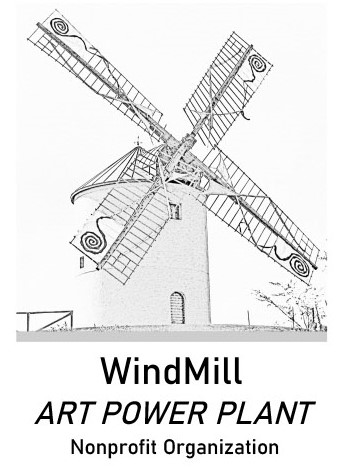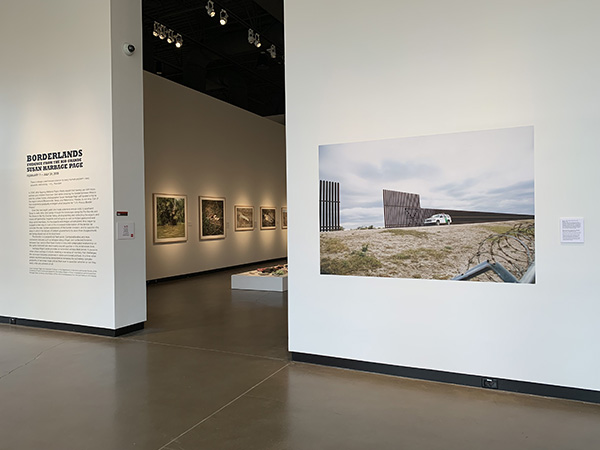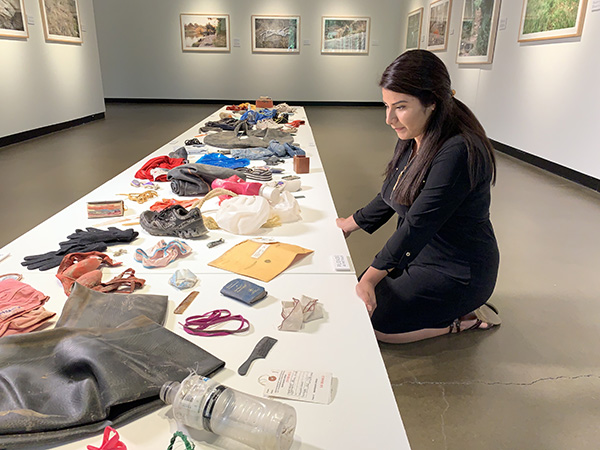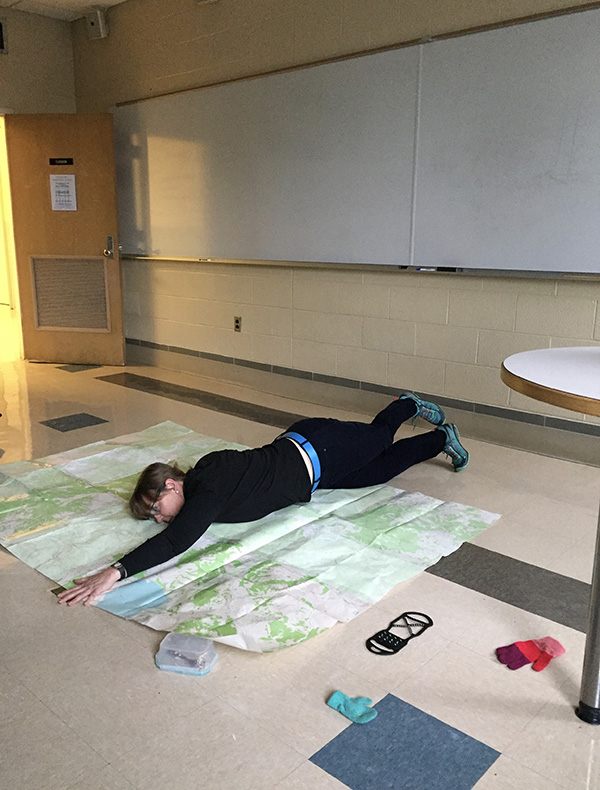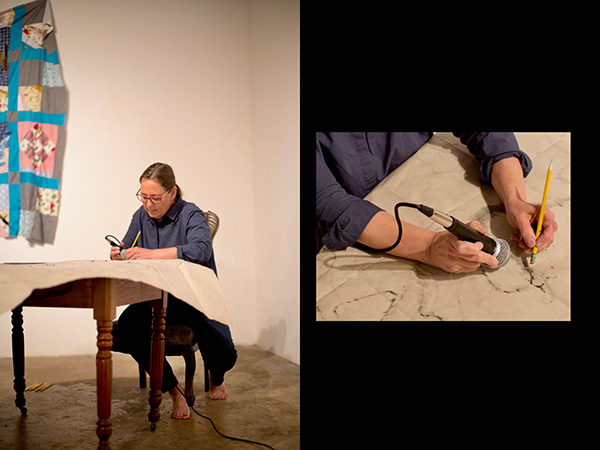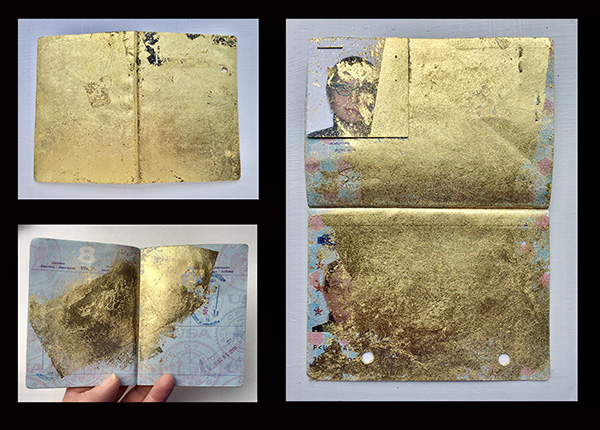
Susan Harbage Page
Biografia
Susan Harbage Page has spent her life crossing borders, both literally and figuratively. Born in Ohio, she moved to North Carolina and thus experienced both sides of the Mason-Dixon line at an early age. In 1969, when Harbage Page was 10 years old, her mother took her and her three sisters on a three-month European camping trip in a red VW bus. The five women crossed 23 borders, including the Iron Curtain countries of Czechoslovakia, Hungary, Yugoslavia, Romania, and Bulgaria. At Romania’s border, agents detained the family for a day. Being trapped between two borders and belonging to neither influenced Harbage Page’s work which explores militarized spaces, borderlands, nation, gender, race, archives, representation, and belonging. Her work springs from a lens-based documentary background. She currently works with photography, video, installation, performance, sculpture, material culture, and painting.
The U.S.-Mexico Border Project (2007-present) the major corpus of Harbage Page’s work has unfolded in three major parts including 1) the “Anti-Archive of Trauma on the U.S.-Mexico Border” of circa 1,000 found objects such as shoes, religious items, and passports left behind by border crossers, 2) 30,000 photographic images of the immediate border area along the Rio Grande in Texas showing the increased militarization and the paths that refugees walk 3) over 17 site-specific actions and interventions in the Rio Grande Valley of Texas that address more personal conversations about representation and privilege that Susan has as she walks, canoes and bikes the border to bear witness in a place where many people cannot walk safely. The project illuminates a history of continuing trauma caused by bordering practices in the Rio Grande Valley. The focus on archives asks the viewer to consider how they shape our histories, whose narratives get included, and whose narratives get left out or abandoned.
Harbage Page holds a master’s degree in Photography from the San Francisco Art Institute (2004), a master’s degree in Music from Michigan State University (1983), and a certificate of knowledge of the Italian Language, from the Universitá Per Stranieri, Perugia, Italy (1984). Her master’s degree in Saxophone Performance from Michigan State University and engagement with the New Music Ensemble at MSU where she studied the work of Laurie Anderson, the Roches, and John Cage and his theories on chance, indeterminacy, silence, and Buddhism. Their music influences her performative works such as La Ragnatella Rossa Performance (2015), Sewn Border Video (2014), Erased Border Video(2015), Erasing the Border Performance (2018-Present), and most recently the video sets for Meredith Monk’s Opera Atlas (2021) about a boy and his dog riding “The Beast” known as the death train north across Mexico to enter the United States.
After graduate school, Harbage Page worked for National Public Radio stations KANZ, WKAR, and WDAV. During this period Harbage Page was a Program Director and on-air host, producing interviews and recording music. This period was formative in her commitment to social justice issues as she was exposed to emerging forms of longer form radio journalism and the early development of the CPB and NPR. She worked at Bollag International, a textile recycling mill in Charlotte, North Carolina, in 1990 when she began her first major documentary project. She photographed and recorded interviews with the women at the mill, addressing issues of voting rights, childcare, gender, relationships, and race.
In 1992, Harbage Page received a Fulbright Scholarship to travel to Italy where she lived with a group of cloistered Augustinian nuns in Spello, Umbria. The sisters—who have become friends—supported themselves by sewing, embroidering, and making lace. Living with women in a sovereign community which on the day-to-day micro level was very independent and on the larger macro level submissive to the patriarchal church intrigued Susan. The nuns supported themselves through the production of handmade goods which led to Harbage Page’s work with textiles. She spends a large portion of every year in Italy, where she concentrates on drawing and painting images on reclaimed Italian book pages from the 16th, 17th, and 18th centuries. These paintings and objects are based on lace collars, doilies, early mechanical spindle loom patterns, and movements of the thread on hand and spindle looms which she researches in both Italy and the U.S. Her work questions who has traditionally been seen as the creator of knowledge and what knowledge is valued by society. Through these handmade and mechanically produced textile objects and books, she unpacks the economic and social histories of previously overlooked women. Her gendered body unites the past with the present as she works back into the marginalia of the antique book pages, produced and written largely by men at a time when many women were not taught to read. She is asking questions not only about who language serves, who it benefits, and who it abandons as well as presenting the textile production of women as an equal form of knowledge and culture which should be preserved in archives.
In 1996, Harbage Page lived in the Negev Desert with a group of indigenous (Bedouin) weavers in Lakiya, Israel while on a Fellowship from the North Carolina Arts Council. The Negev Women’s Weaving Cooperative heightened her understanding of ways in which we can empower women. Since her residency collided with the Grapes of Wrath offensive, the experience also sharpened her awareness of military violence.
Her work can be found in the collections of The Baltimore Museum of Art., The Houston Museum of Art, The Israel Museum of Art in Jerusalem, The Nasher Museum of Art, The Mint Museum of Art, The High Museum of Art, and The Weatherspoon Museum of Art, as well as others.
Amongst Page’s awards are fellowships from the North Carolina Arts Council, the Camargo Foundation, The McColl Center for Visual Arts, and the Institute for Arts and Humanities, UNC-Chapel Hill, an Academic Excellence Award from the Institute for Arts and Humanities UNC-Chapel Hill, the Carolina Women’s Center Faculty Scholar Award UNC- Chapel Hill, as well as funding from the Andy Warhol Foundation and the Fulbright Program. She is an awardee of the Bernice Abbott International Competition for Women in Documentary Photography. Her work has been exhibited around the globe including, the U.K, Italy, France, China, Israel, Germany, Bulgaria and Slovenia among others. Seven monographs about her work have been published in conjunction with solo exhibitions.
Harbage Page is currently an Associate Professor in the Department of Women’s and Gender Studies at UNC-Chapel Hill where she teaches a curriculum that combines hands-on artmaking process with feminist thought and social justice activism. She lives and works in Chapel Hill, NC and Spello, Italy.
Curriculum
Education
2004 M.F.A. – San Francisco Art Institute, California (photography)
1984 C.K. – Certificate of Knowledge of the Italian Language, The Italian – University for Foreigners/Perugia, Italy
1983 M.M. – Michigan State University, East Lansing (saxophone performance)
1981 B.M. – Michigan State University, East Lansing (saxophone performance)
Professional Experience
2018- present – Associate Professor, Department of Women’s and Gender Studies, UNC-Chapel Hill
2012 – 2018 – Assistant Professor, Department of Women’s and Gender Studies, UNC-Chapel Hill
2006 – 2017 – Program Leader/Facilitator, leadership, innovation, and creativity programs for business leaders, McColl Center for Arts and Innovation, Charlotte, North Carolina
2005 – 2012 – Lecturer, Studio Art (photography), UNC-Chapel Hill
Honors, Artist Residencies, Awards, Grants
2021 – Humanities Expert, NC Humanities Community Engagement Grant, East Carolina University, Megan A. Perry
2019 – Il Sangue Delle Donne by Manuela De Leonardis, my artwork included in the book, Postmedia Books. Selected as one of 10 best art books for 2019 by Artribune, Rome, Italy
2019 – Best of Show Publication Award, Southeastern Museums Conference for Evidence from the Rio Grande, Published by the Gregg Museum of Art
2019 – Beam Makerspace Course Development Grant, UNC-Chapel Hill
2019 – Curriculum Development Grant, Center for European Studies (CES), UNC-Chapel Hill
2018 – Borders and Belonging (fiscal sponsorship), Southern Documentary Fund,
2018 – Publication Grant for Border Portfolio, University Research Council, UNC-Chapel Hill
2018 – Publication Grant for Border Portfolio, Lubo Fund, Atlanta, Georgia
Durham, North Carolina
2017 – International Travel Grant, Center for European Studies, UNC-Chapel Hill
2017 – Curriculum Development Grant, Center for European Studies, UNC-Chapel Hill
2016 – Academic Excellence Award, Institute for Arts and Humanities, UNC-Chapel Hill
2016 – Honorary Order of the Grail-Valkyries, UNC-Chapel Hill
2015 – Fellowship Institute for the Arts and Humanities, UNC-Chapel Hill
2015 – Learning from Artists’ Archives: Preparing Next Generation Art Information Professionals through Partnerships with North Carolina’s Artists’ Archives, artist participant, Museum and Library Services (IMLS), UNC-Chapel Hill
2014 – Carolina Women’s Center Faculty Scholar Award, UNC-Chapel Hill
2002 – Camargo Foundation Fellowship and Residency, Cassis, France
2000 – Visual Artist Fellowship, North Carolina Arts Council, Raleigh, North Carolina
2000 – The Berenice Abbott International Competition for Women In Documentary Photography, Awardee/Second Prize, Springfield Museum of Art, Springfield, Ohio
1996 – North Carolina to Israel Artist Residency and Fellowship to Israel and Palestine, North Carolina Arts Council, Raleigh, North Carolina
1992 – Fulbright Travel Grant, Fulbright Scholars Program, Spello, Italy
Selected Solo Exhibitions
2022 Susan Harbage Page: Border Retrospective, Davidson College Art Galleries, Davidson, North Carolina
2021 The Art of Migration (Joint with Sally Jacobs), East Carolina University, Greenville, North Carolina
2021 Between the River and the Wall, Sumter County Gallery of Art, South Carolina
2021 Atlas, Opera by Meredith Monk, produced video scenography, UNC Opera,
UNC-Chapel Hill *Postponed due to Covid-19 Crisis, Video Performance completed Spring 2021.
2020 Crossing Boundaries Process Series, Atlas, opera by Meredith Monk, video sets, UNC-Chapel Hill
2019 Borderlands: Evidence from the Rio Grande, Gregg Museum of Art, NC State University, Raleigh, North Carolina (catalogue published)
2019 Borders and Belonging Portfolio, Limited Edition of seven Portfolios of 25 original Photographs with catalogue, Essays by Manuela De Leonardis, Audrey Goodman, China Medel, and Elisabeth Vallet, Lubo Fund, Publication Grant UNC-Chapel Hill, Southern Documentary Fund (Fiscal Sponsorship) and UNC-Chapel Hill, Durham, North Carolina
2018 Erasing the Border Performance, University of Québec, Montreal
2018 Dreaming Spello, Spello Fotofes, Italy
2018 Erasing the Border Performance, META Museum Conference, Black Mountain, North Carolina
2018 Erasing the Border Performance, Visual Arts Exchange, Raleigh, North Carolina (two performances)
2017 Tessitura/Weaving, curated by Franco Troiani, Premiere Screening of Tessitura/Weaving, video poem, Museo della Canapa a Sant’Anatolia di Narco, Umbria, Italy
2015 The Red Spider Web/La Ragnatela Rosa (performance and installation), Villa Pacchiani, Santa Croce Sull’Arno, Italy (Pisa), curated by Manuela De Leonardis + Ilaria Mariotti
Selected Group Exhibitions
2021 Underexposed: Women Photographers from the Collection, The High Museum of Art, Atlanta, Georgia
2021 Il sangue delle donne. Tracce di rosso sul panno bianco, Palazzo Fruscione, Salerno, Italy,), Supported by the Filiberto e Bianca Menna Foundation and the Pasquale Battista Foundation.
2021 Io e Me: Autoritratti nel Periodo Del Lockdown, Biblioteca Nazionale di Roma and Sala 1 Gallery, Rome, Italy (forthcoming in November)
2021 Celebrating Women: Female Artists from the Permanent Collection, Springfield Museum of Art, Springfield, Ohio
2020 Il sangue delle donne, Trace di rosso sul panno bianco, Scuola di communicazione social di genere, Giuglio Cavazza Exhibition Hall, Bologna, Italy, Nov. 7 to 30, 2020
2020 Permanent Collection Galleries (with Central to their Lives/Southern Women Artists), Gibbes Museum of Art, Charleston, South Carolina
2020 Migrations and Meaning(s) in Art, Maryland Institute College of Art, Baltimore (curated by Deborah Willis)
2019 Kith + Kin, Lunder Arts Center, Cambridge, Massachusetts
2019 Museum Reflects Twice Celebration of Prop Master, Mary Jackson Modern and Contemporary Gallery, Gibbes Museum of Art, Charleston, South Carolina
2019 Corpomente: Arte e Medicina Lavorano, II Internazionale D’Arte Contemporanea, Curated by Sara Ciuffeta, Chieti, Italy
2018 Repeat After Me, Electro Studio Project Space, St Leonards-on-the-Sea, England
2018 Across County Lines, Nasher Museum of Art at Duke University, Durham, North Carolina
2017 Imagining Home, Baltimore Museum of Art, Maryland
Selected Monographs Published as Catalogues for Solo Exhibitions
2019 Borders and Belonging Catalogue, Limited Edition Portfolio of 25 original p hotographs with catalogue, Essays by Manuela De Leonardis, Audrey Goodman, China Medel, and Elisabeth Vallet, Lubo Fund, Fiscal Sponsorship Southern Documentary Fund and UNC-Chapel Hill, Durham, North Carolina
2019 Borderlands: Evidence from the Rio Grande, Gregg Museum of Art at NCSU, Raleigh, North Carolina
2013 Lo Strappo Della Storia: Conversazione Con Merletti/History’s Pull: Conversations with Lace, essays by Manuela De Leonardis + Lia Newman, Casa Della Memoria e Della Storia, Rome, Italy
2012 The Border Project: New Work by Susan Harbage Page, essay by Lauren Turner, Flanders Art Gallery, Raleigh, North Carolina
2009 Susan Harbage Page: Lingering Portraits, essay by Shannon Egan, PhD, Gettysburg College, Gettysburg, Pennsylvania
2007 Postcards from Home, essay by Laurel Fredrickson, PhD, Sumter Gallery of Art, Sumter County Cultural Commission, Sumter, South Carolina
2006 Involuntary Memories, essays by Margaret A. Skove + Terrence Pitts, Blanden Memorial Art Museum, Fort Dodge, Iowa
2003 Ties That Bind, essays by Michael Lesy + Martha R. Severens, Emrys Journal, Greenville County Museum of Art, Greenville, South Carolina
2002 Standing Still, essays by Svetlana Mintchevea + Shannon Egan, ATA Center for Contemporary Art, Sofia, Bulgaria
Selected Catalogues Published for Group Exhibitions
2020 Migrations and Meaning(s), Curated by Deborah Willis, Maryland Institute College of Art, Baltimore, Maryland
2019 Corpomente: Arte e Medicina Lavorano, II Internazionale D’Arte Contemporanea, Curated by Sara Ciuffeta, Chieti, Italy
2019 Il Sangue Delle Donne, essay and curation by Manuela De Leonardis, Fondazione Battistsa, Rome/Bari, Italy
2018 Across County Lines: Contemporary Photography from the Piedmont, Nasher Museum of Art at Duke University
2018 Created by Light, Cameron Art Museum, Wilmington, North Carolina
2017 Ženska Krv: The Blood of Women, essay by Manuela De Leonardis, Galerija Forum, Zagreb, Croatia
Artist Bibliography Selected
Books in this category include selected articles/essays/references written by me. It also included collaborations with art historians/scholars and/or my images published as portfolios.
2022 Geopolitics, Special Issue, “My Gold-Leafed Passport” article and photographs by Susan Harbage Page, edited by Èlizabeth Vallet, Taylor and Francis
2021 Puppet and Spirit: Investigations in Material Performance and Bodiless Presence published by Routledge, Ana Martinez, Routledge
2021 Liquid Borders: Migration as Resistance by Mabel Moraña, Taylor and Frances
2021 A Planetary Lens: The Photo-Poetics of Western Women’s, Writing, Audrey Goodman, Taylor and Francis/Feltrinelli
2020 Performing Human Rights: Contested Amnesia and Aesthetic Practices in the Global South, Edited by Liliana Gómez, Chapter 8, essay by Stephanie Young: Bound Boundary-aesthetics: obscured scenographies of violence at the US/Mexican Border, distributed by Diaphanes, The University of Chicago, Press (forthcoming), 2020
2019 “Re-locating the US-Mexico Borderlands: Susan Harbage Page’s Vibrant Contact Zones.” by Audrey Goodman, Studies in the Literary Imagination, vol. 50 no. 1, 2017, Department of English, Georgia State University (publication delayed to 2019)
2019 Talking Trash: Cultural Uses of Waste, Maite Zubiaurre, UCLA, Book published by Vanderbilt University Press
2019 Women and Mass Violence, “Frontière Hostile, Frontière Violente,” by Èlisabeth Vallet, Spirale Journale, essay by Èlizabeth Vallet, Diffusion Gallimard, Montréal, Québec.
Digital Initiatives
2020 Borderlands Exhibition, Virtual Tour, Gregg Museum of Art, Raleigh, North Carolina, https://gregg.arts.ncsu.edu/exhibitions/borderlands-evidence-from-the-rio-grande/
2019 Revisiting Prop Master, Lowcountry Digital History Initiative, digital history project hosted by the Lowcountry Digital Library of the College of Charleston.
http://ldhi.library.cofc.edu/exhibits/show/revisiting-prop-master/landing-page
Selected Refereed Articles, Magazine Articles, Blogs *refereed
2021 The risk of being a-political: can “border art” become a polity-call, essay by Anne Laura Amilhat Szary, The Large Glass Journal of Contemporary Art
2020 The Archive as Evidence, By Jane Booth, Tesserae: Anachronistic, innovative interpretaions of art history, theory and criticism by emerging creative voices https://medium.com/tesserae/the-archive-as-evidence-24898054775a
2020 * Gold-Leafed Passport, Art and Vision, Southern Cultures Journal, Edited by Teka Selman, essay by Deb Willis, Summer 2020
2020 Discovering Kith+Kin, Artscope Magazine, by Olivia MacDonald
2020 Transient Borders Conference, Images used for publicity and conference pr, UNC-Chapel Hill, North Carolina
2019 Artist Profile: Susan Harbage Page, by Lizzie Cheatham McNairy, Matrons and Mistresses Blog, https://www.matronsandmistresses.com/blog/2019/06/07/susan-harbage-page
2018 * Pathways into the Borderlands, photos by Susan Harbage Page, essay by Audrey Goodman, Five Points Journal, Georgia State University, Vol. 18, No. 2
2018 * To What Do I Belong?: Traversing Differences, Bridging Narratives, artwork by Susan Harbage Page, edited by Nataša Durovočová editor, online publication of the International Writing Program, US Department of State and Iowa University, http://iwpcollections.squarespace.com/to-what-do-i-belong-traversing-differences-bridging-narratives#narrative-belonging-home
2017 * Geopolitical television at the (b)order: liminality, global politics, and world-building, by Robert Saunders, Social and Cultural Geography Journal, Taylor and Fancis
Selected Videos and Podcasts About My Work Selected
2021 “Contemplating the Border with Susan Harbage Page”, Inside the Benton: the podcast of the Benton Museum of Art at Pamona College, https://open.spotify.com/episode/2Uwd4tNLRF5zcvKArTe8tf?si=8M7EydhXQsqnMk3gzL7Tzw
2020 Susan Harbage Page: KANZ 40 Year Anniversary Interview, High Plains Public Radio, Garden City, Kansas, Broadcast June 2020.
2019 A Photographer Finds the Story in the Things Left Behind on the Border, Things with Frank Stasio, WUNC, Durham, North Carolina (July 4 and March 18). Selected to be rebroadcast on July 4th as one of the “best of” interviews.
2018 Susan Harbage Page, Episode 12, Don’t You Lie to Me: Visual Arts Podcast, NC
Reviews of Scholarship/Exhibitions
2021 In Atlanta an Exhibition of Photography made Exclusively by Women, by Nancy Coleman, New York Times, New York, 4/20/21
2021 Joe Biden sauvera-t-il la culture américaine ? by Charles-Éric Blais-Poupin, La Presse, Montreal, Quebec 01/16/21
2020 Susan Harbage Page, un puzzle di oggetti per raccontare l’identità dei «clandestini», By Manuela De Leonardis, Rome, Italy, 10/24/20
2020 How Artists and Arts Institutions Lead the Conversation on Race, by Adam Parker, The Post and Courier, Charleston, South Carolina, 7/25/20
2019 Fotógrafa conmemoria historias de inmigrantes en su exposición “Borderlands: Evidencia del Río Grande,” by Guadalupe Ramos, QuéPasa, Raleigh, Durham
Selected Invited Lectures
2021 From the Artist’s Studio: Susan Harbage Page, Duke University OLL Institute,
2020 Borderlands: Evidence from the Rio Grande, Gregg Museum of Art. Oct. 22
2020 Queering the Border, Davidson College, North Carolina (Art Gallery), Feb. 8
2019 Il Sangue Delle Donne, Il Museo di Arte Moderna é Contemporaneo, Rome, Italy
2018 Embroidery as Art, Museo Palazzo Mocenigo, Venice Italy
2017 Objects from the Borderlands and [Non] Belonging, Immigration Awareness Series, sponsored by Latin American Studies, Northern Arizona State University
Public and Community Service/Engagement Conferences and Panels Selected
2021 Race, Racism and Racial Equity (R3) Symposium: Using Arts-based Scholarship to Interrogate and Dismantle Racism, panelist, University Office for Diversity and Inclusion, Jordan Institute for Families, UNC School of Social Work, UNC-Chapel Hill
2020 CFE Faculty Showcase on Teaching, Panel Presentation “Grading in the Gray: Assessing Creative Work” *Postponed due to Covid-19 Crisis
2020 Counter Cartographies, Presented IDST 190 Experiencing Latin America student artwork to Orto Degli Aghi, Assisi, Italy
2020 Myers Park United Methodist Church, Worked with the Rev. Nathan Arledge, Pastor of Missions and Global Engagement, to plan border workshop for 12 participants over spring break in Brownsville, Texas, and Matamoros, Mexico. We delivered 2,000 meals to the Asylum Seekers Refugee Camp in Matamoros.
Borderlands Exhibition
U.S.-Mexico Border Project (2007-present): Borderlands Exhibition, Gregg Museum of Art, North Carolina State University, Installation image
Anti-Archive of Trauma
Anti-Archive of Trauma on the U.S. Mexico Border (part of the U.S.-Mexico Border Project (2007-Present), Gregg Museum of Art, North Carolina State University, Installation Image
The Map Is Not The Territory
The Map Is Not The Territory: Bodies, Borders, and Geographies Performance, University of North Carolina at Chapel Hill – Maps, Thread, Mittens, Tape, Rubber Ice Shoes, Plastic Container, Spoon, Banana, Body
Erasing the Border Performance
Erasing the Border Performance, University of Québec, Montreal; Black Mountain College, North Carolina; and Visual Arts Exchange, Raleigh, North Carolina, Montreal, Canada U.S.A. – Handmade Abaca Paper, Table, Chair, Microphone, Tape, Pencils with Erasers
My Gold-Leafed Passport
2018 – Gold-Leaf, Susan Harbage Page’s U.S. Passport
